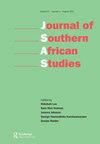‘van die oorspronklike lippe’ (‘from the original lips’): The 19th-Century Cape Colony, Holographic Archaeology and the Historicity of Gideon von Wielligh’s /xam–Afrikaans Collection
IF 0.7
4区 社会学
Q2 AREA STUDIES
引用次数: 1
Abstract
This article investigates the historicity of Gideon von Wielligh’s collection of /xam folklore, history, and observational accounts published predominantly in Afrikaans during the early 20th century. Von Wielligh’s collection is often portrayed as suspect in relation to the ‘great’ /xam archive, namely that of Wilhelm Bleek and Lucy Lloyd – with accusations of plagiarism a common charge. Through a holographic archaeological reading, an approach conceptualised by drawing on linguistic archaeology and philology specifically, and the holographic paradigm and archaeology of knowledge in general, the article analyses the traces of /xam in Von Wielligh’s otherwise Afrikaans texts. The reading focuses on Von Wielligh’s texts on the one hand and Specimens of Bushman Folklore (1911) on the other. Since Specimens was the only selection from the Bleek and Lloyd archive to which von Wielligh had access when he published his collection between 1919 and 1921, it is, within holographic archaeological terms, the ‘urtext’ or ‘source of certainty’. In contrast, von Wielligh’s texts are regarded as the ‘source of suspicion’, with the /xam linguistic data within it ‘dated’ in relation to Specimens. The analysis leads to the following three conclusions: first, von Wielligh’s command of /xam linguistic data validates the authenticity of the collection; second, we can use von Wielligh’s recordings to change the idea of the extant /xam archive in a way that challenges the fixation on Bleek and Lloyd; third, the politics of intellectual history, such as the defaming of von Wielligh, is tied not simply to ideas but to the history of the book as a material object. This acknowledgement and changed perspective on the /xam and the available records could, in turn, lead to deeper and more generative research on the /xam specifically, Khoesan studies generally and South (and southern) African studies more broadly.“van die oorsponklike lippe”(“来自最初的嘴唇”):19世纪开普殖民地、全息考古和Gideon von Wielligh/xam的历史——南非荷兰语收藏
本文调查了吉迪恩·冯·维利格(Gideon von Wielligh)在20世纪初主要用南非荷兰语出版的民间传说、历史和观察记述集的历史性。Von Wielligh的收藏经常被描绘成与“伟大”/xam档案有关的嫌疑人,即Wilhelm Bleek和Lucy Lloyd的档案,抄袭指控是常见的指控。通过全息考古阅读,这是一种通过具体借鉴语言考古学和文献学,以及全息范式和知识考古学而概念化的方法,本文分析了Von Wielligh的其他南非荷兰语文本中/xam的痕迹。阅读的重点一方面是冯的文本,另一方面是布什曼民俗标本(1911)。由于《标本》是冯·维利格在1919年至1921年间出版藏品时从布莱克和劳埃德档案馆中唯一可以访问的作品,因此,在全息考古术语中,它是“文本”或“确定性的来源”。相比之下,冯·维利格的文本被视为“怀疑的来源”,其中的/xam语言数据与样本有关。分析得出以下三个结论:首先,冯·维利格对/xam语言数据的掌握验证了该集合的真实性;其次,我们可以使用冯·维利格的录音来改变现存/xam档案的想法,以挑战对Bleek和Lloyd的执着;第三,知识史的政治,例如对冯·维利格的诽谤,不仅与思想有关,而且与作为实物的书籍的历史有关。这种对/xam和现有记录的认识和观点的改变,反过来可能会导致对/xam的更深入、更具创造性的研究,特别是对Khoesan的研究,以及对南非(和南部)更广泛的研究。
本文章由计算机程序翻译,如有差异,请以英文原文为准。
求助全文
约1分钟内获得全文
求助全文
来源期刊

Journal of Southern African Studies
AREA STUDIES-
CiteScore
1.40
自引率
0.00%
发文量
73
期刊介绍:
The Journal of Southern African Studies is an international publication for work of high academic quality on issues of interest and concern in the region of Southern Africa. It aims at generating fresh scholarly enquiry and rigorous exposition in the many different disciplines of the social sciences and humanities, and periodically organises and supports conferences to this end, sometimes in the region. It seeks to encourage inter-disciplinary analysis, strong comparative perspectives and research that reflects new theoretical or methodological approaches. An active advisory board and an editor based in the region demonstrate our close ties with scholars there and our commitment to promoting research in the region.
 求助内容:
求助内容: 应助结果提醒方式:
应助结果提醒方式:


